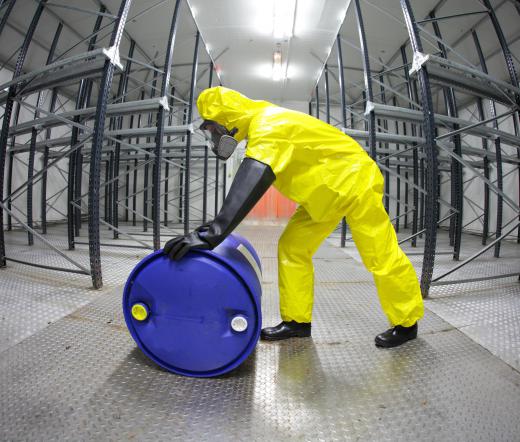Hazardous materials, also known as Hazmat or dangerous goods, are solids, liquids, or gasses that are generally classified as potentially dangerous to people, animals, or the environment. Hazardous material shipping usually requires a precise method of transportation to avert these potential threats. These methods can vary depending on what kind of hazardous material is being shipped and in which countries they are being transported.
The methods for hazardous material shipping generally can be broken down into three parts. A hazardous material is usually classified according to what type of hazardous material it is, and then marked accordingly. An appropriate means of transport also needs to be selected for the hazardous material. The shipping and transportation of the hazardous material itself usually is handled by a trained professional selected for the task.

Before shipping any hazardous material, most western countries require a classification and marking system of the dangerous goods. This can help in the identification of what kind of Hazmat is being transported. For example, hazardous materials can be classified as explosives, compressed gasses, flammable liquids, flammable solids, oxidizers, radioactive materials, corrosive liquids, or miscellaneous. Each of these individual classifications normally consists of sub groups, which further specifies the type of Hazmat. Diamond-shaped color and design codes generally are used to distinguish these types, providing immediate information as to the contents of the dangerous goods.
Transportation methods for hazardous waste usually depend upon the type of hazardous waste that is to be shipped. Hazmat can be shipped using vehicles such as planes, trains, or trucks. Many types of trucks can be employed for hazardous material shipping. These include lorries, bulk tankers, ISO tank containers, tube trailers, and lorries with bulk tanks. As these trucks often use public highways for their shipping routes, placards often are placed on the outside of vehicles to make people aware that Hazmat is being transported.
Sometimes, workers ship hazardous material by hand. This can generally be the result of not knowing a material is hazardous. Many times it can be the sign of corrupt business practices, where Hazmat regulations are ignored, as well as worker safety standards.
Workers involved in hazardous material shipping usually are required to have some type of accreditation. This can mean undergoing extensive training and passing a test to become a certified shipper or transporter. According to the dangerous nature of Hazmat, this is normally required to ensure the safest transportation possible.
